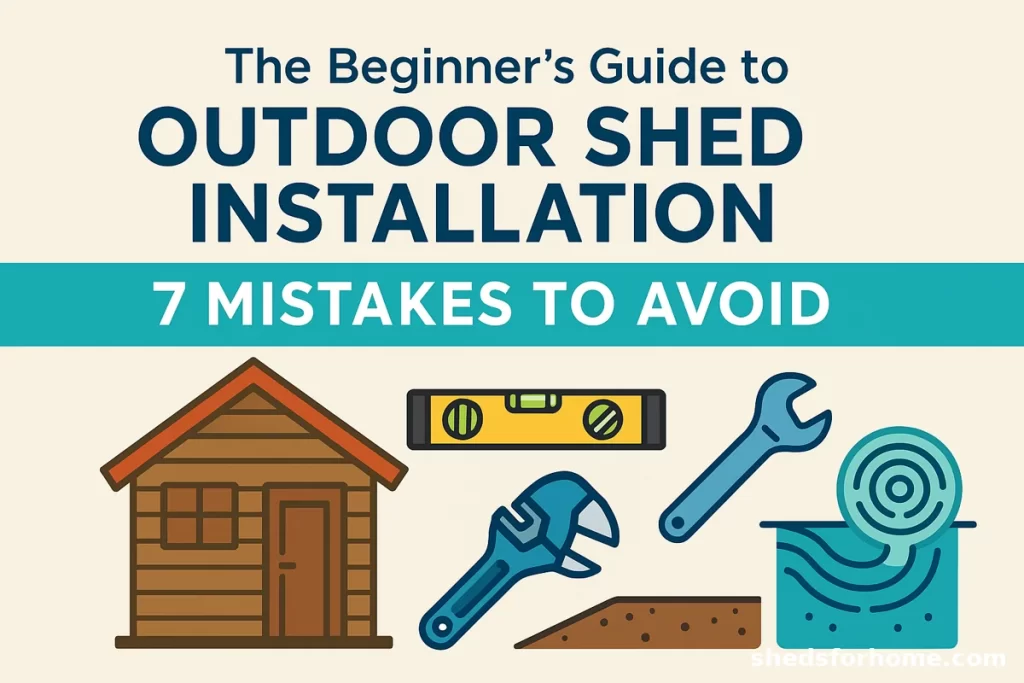🏡 Introduction: Why This Guide Matters
Outdoor shed installation may seem simple—but even experienced DIYers fall into common traps that can cost time, money, and long-term durability. Whether you’re setting up a resin kit, building a wooden structure, or anchoring a prefab shed, a few overlooked details can lead to crooked floors, water damage, or code violations.
In this beginner-friendly guide, we’ll walk you through the 7 most common shed installation mistakes and show you how to avoid them with simple, field-tested fixes.
⚠️ Mistake #1: Skipping Site Preparation
The Problem: Rushing to build on uneven or soft ground leads to instability, pooling water, and early structural failure.
The Fix:
Clear the area of grass, roots, and debris.
Level the ground using a long 2×4 and a bubble level.
Add a compacted gravel base or concrete pad depending on your shed type.
🔗 Related: Concrete vs. Gravel Shed Foundations →
⚠️ Mistake #2: Ignoring Building Codes & HOA Rules
The Problem: You install the shed… and get a letter saying it must be removed.
The Fix:
Check with your city or county for shed permit requirements.
Confirm setbacks, height limits, and drainage regulations.
Ask your HOA (if applicable) about pre-approval or design standards.
💡 Pro Tip: Always get this in writing before breaking ground.
⚠️ Mistake #3: Not Checking for Underground Utilities
The Problem: You dig… and hit a gas or electrical line.
The Fix:
Call 811 (in the U.S.) before you dig to mark underground lines.
Avoid placing your shed over water mains, septic tanks, or drain fields.
📌 Bonus: This is free, fast, and required by law in most areas.
⚠️ Mistake #4: Choosing the Wrong Foundation
The Problem: Sheds sink, doors jam, and water seeps in.
The Fix:
Gravel base: Flexible, drains well, good for plastic/resin sheds.
Concrete slab: Long-lasting, level, better for heavy wooden sheds.
Add pressure-treated framing skids if your kit requires it.
⚠️ Mistake #5: Using Indoor Hardware Outdoors
The Problem: Rusty screws and nails weaken the structure over time.
The Fix:
Use galvanized, stainless steel, or coated fasteners.
Follow the shed kit’s manual for approved hardware.
📌 DIY Tip: Label your hardware sets by step for faster assembly.
⚠️ Mistake #6: Forgetting to Waterproof & Ventilate
The Problem: Trapped moisture leads to mold, rot, and musty odors.
The Fix:
Seal edges with caulk and weatherproof paint or stain.
Add ridge vents or gable vents for airflow.
Keep items off the floor using shelving or pallets.
🔗 Related: How to Waterproof Your Outdoor Shed →
⚠️ Mistake #7: No Plan for Drainage or Access
The Problem: Your shed floods or is impossible to reach in muddy seasons.
The Fix:
Build a slight slope (1–2%) for runoff.
Add crushed stone or pavers around the perimeter.
Leave 3–5 feet of clearance on all sides for maintenance.
📷 Want it to last 20+ years? Water management is the key.
✅ Final Thoughts: Build Smart from the Ground Up
Installing a shed should be a satisfying weekend project—not a frustrating one. By planning ahead and avoiding these 7 beginner mistakes, you’ll create a storage space that’s solid, legal, dry, and built to last. Don’t forget to check out the complete step-by-step guide to install an outdoor shed.
📥 Bonus: Get Your Free Outdoor Shed Setup Checklist
Download our printable Shed Setup Checklist to stay organized and avoid surprises on install day.


